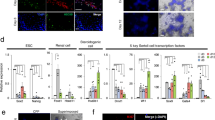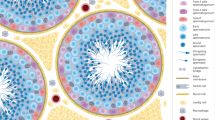Abstract
The in vitro propagation of mouse spermatogonial stem cells (SSCs) became possible in 2003; these cultured SSCs were named germ-line stem (GS) cells. To date, however, it has not been possible to induce spermatogenesis from GS cells in vitro. Recently, we succeeded in producing functional sperm from primitive spermatogonia in explanted neonatal mouse testis tissues. Here we describe a protocol that can support spermatogenesis from GS cells up to sperm formation in vitro using an organ culture method. GS cells transplanted in the extracted testis form colonies in the tissue fragments and differentiate into sperm under the described in vitro organ culture conditions. It takes about 6 weeks to obtain sperm from GS cells. The sperm are viable, resulting in healthy offspring through micro-insemination. Thus, this protocol should be a valuable tool for the study of mammalian spermatogenesis.
This is a preview of subscription content, access via your institution
Access options
Subscribe to this journal
Receive 12 print issues and online access
$259.00 per year
only $21.58 per issue
Buy this article
- Purchase on Springer Link
- Instant access to full article PDF
Prices may be subject to local taxes which are calculated during checkout





Similar content being viewed by others
References
Martinovitch, P.N. Development in vitro of the mammalian gonad. Nature 139, 413 (1937).
Steinberger, A., Steinberger, E. & Perloff, W.H. Mammalian testes in organ culture. Exp. Cell Res. 36, 19–27 (1964).
Staub, C. A century of research on mammalian male germ cell meiotic differentiation in vitro. J. Androl. 22, 911–926 (2001).
Griswold, M.D. & Oatley, J.M. Concise review: defining characteristics of mammalian spermatogenic stem cells. Stem Cells 31, 8–11 (2013).
Gohbara, A. et al. In vitro murine spermatogenesis in an organ culture system. Biol. Reprod. 83, 261–267 (2010).
Sato, T. et al. In vitro production of functional sperm in cultured neonatal mouse testes. Nature 471, 504–507 (2011).
Sato, T. et al. Testis tissue explantation cures spermatogenic failure in c-Kit ligand mutant mice. Proc. Natl. Acad. Sci. USA 109, 16934–16938 (2012).
Kanatsu-Shinohara, M. et al. Long-term proliferation in culture and germline transmission of mouse male germline stem cells. Biol. Reprod. 69, 612–616 (2003).
Kanatsu-Shinohara, M. et al. Production of knockout mice by random or targeted mutagenesis in spermatogonial stem cells. Proc. Natl. Acad. Sci. USA 103, 8018–8023 (2006).
Takehashi, M. et al. Adenovirus-mediated gene delivery into mouse spermatogonial stem cells. Proc. Natl. Acad. Sci. USA 104, 2596–2601 (2007).
Brinster, R.L. & Zimmermann, J.W. Spermatogenesis following male germ-cell transplantation. Proc. Natl. Acad. Sci. USA 91, 11298–11302 (1994).
Ogawa, T., Arechaga, J.M., Avarbock, M.R. & Brinster, R.L. Transplantation of testis germinal cells into mouse seminiferous tubules. Int. J. Dev. Biol. 41, 111–122 (1997).
Sato, T. et al. In vitro production of fertile sperm from murine spermatogonial stem cell lines. Nat. Commun. 2, 472 (2011).
Ogawa, T. et al. Derivation and morphological characterization of mouse spermatogonial stem cell lines. Arch. Histol. Cytol. 67, 297–306 (2004).
Kita, K. et al. Production of functional spermatids from mouse germline stem cells in ectopically reconstituted seminiferous tubules. Biol. Reprod. 76, 211–217 (2007).
Nakanishi, T. et al. Real-time observation of acrosomal dispersal from mouse sperm using GFP as a marker protein. FEBS Lett. 449, 277–283 (1999).
Kubota, H., Avarbock, M.R. & Brinster, R.L. Growth factors essential for self-renewal and expansion of mouse spermatogonial stem cells. Proc. Natl. Acad. Sci. USA 101, 16489–16494 (2004).
Kim, J., Seandel, M., Falciatori, I., Wen, D. & Rafii, S. CD34+ testicular stromal cells support long-term expansion of embryonic and adult stem and progenitor cells. Stem Cells 26, 2516–2522 (2008).
Yokonishi, T., Sato, T., Katagiri, K. & Ogawa, T. In vitro spermatogenesis using an organ culture technique. Methods Mol. Biol. 927, 479–488 (2013).
Acknowledgements
This work was supported by a Grant-in-Aid for Scientific Research on Innovative Areas, 'Regulatory Mechanism of Gamete Stem Cells' 20116005 (to T.O.); a Grant-in-Aid for Scientific Research (B) 24390371 (to T.O.); a Grant-in-Aid for Young Scientists (B) 24770216 (to T.S.); a grant for Research and Development Project II of Yokohama City University (to T.O.); and a grant for Establishment of Research Center for Clinical Proteomics of Post-translational Modifications (to T.O.).
Author information
Authors and Affiliations
Contributions
T.S., K.K. and T.O. wrote the manuscript. Y.K. supervised the research.
Corresponding authors
Ethics declarations
Competing interests
The authors declare no competing financial interests.
Supplementary information
Supplementary Video 1
In vitro transplantation procedure. Preparation of testis, dissociation of efferent ducts, insertion of glass needle, and injection of dye solution into the rete cavity, which spread into the lumen of the seminiferous tubules. (MOV 10100 kb)
Rights and permissions
About this article
Cite this article
Sato, T., Katagiri, K., Kubota, Y. et al. In vitro sperm production from mouse spermatogonial stem cell lines using an organ culture method. Nat Protoc 8, 2098–2104 (2013). https://doi.org/10.1038/nprot.2013.138
Published:
Issue Date:
DOI: https://doi.org/10.1038/nprot.2013.138
This article is cited by
-
Generation of rat offspring using spermatids produced through in vitro spermatogenesis
Scientific Reports (2023)
-
Ex-Vivo and In-Vivo Expansion of Spermatogonial Stem Cells Using Cell-Seeded Microfluidic Testis Scaffolds and Animal Model
Cell and Tissue Banking (2023)
-
Temperature sensitivity of DNA double-strand break repair underpins heat-induced meiotic failure in mouse spermatogenesis
Communications Biology (2022)
-
Dysregulation of Notch-FGF signaling axis in germ cells results in cystic dilation of the rete testis in mice
Journal of Cell Communication and Signaling (2022)
-
Rat in vitro spermatogenesis promoted by chemical supplementations and oxygen-tension control
Scientific Reports (2021)
Comments
By submitting a comment you agree to abide by our Terms and Community Guidelines. If you find something abusive or that does not comply with our terms or guidelines please flag it as inappropriate.



